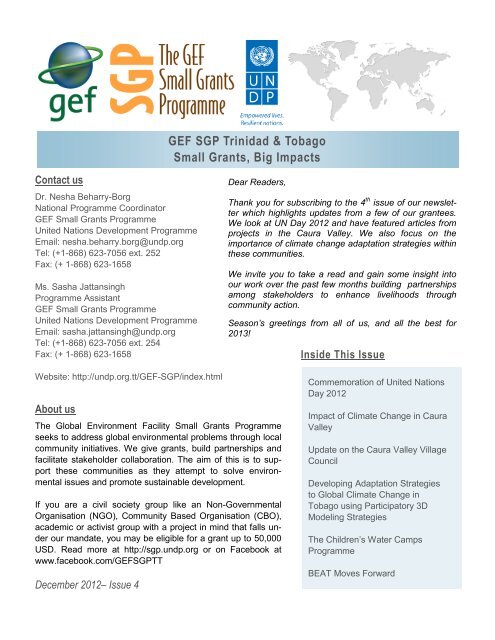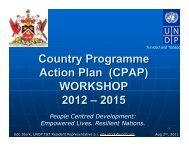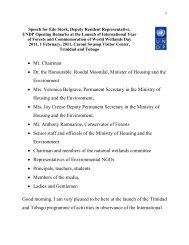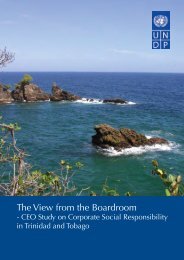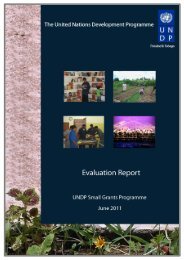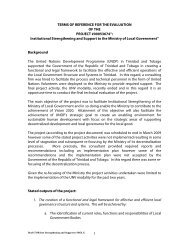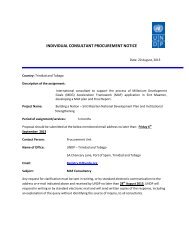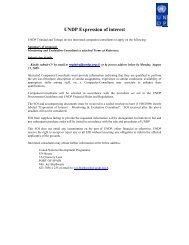GEF Newsletter 4th Edition - UNDP Trinidad and Tobago
GEF Newsletter 4th Edition - UNDP Trinidad and Tobago
GEF Newsletter 4th Edition - UNDP Trinidad and Tobago
Create successful ePaper yourself
Turn your PDF publications into a flip-book with our unique Google optimized e-Paper software.
<strong>GEF</strong> SGP <strong>Trinidad</strong> & <strong>Tobago</strong><br />
Small Grants, Big Impacts<br />
Contact us<br />
Dr. Nesha Beharry-Borg<br />
National Programme Coordinator<br />
<strong>GEF</strong> Small Grants Programme<br />
United Nations Development Programme<br />
Email: nesha.beharry.borg@undp.org<br />
Tel: (+1-868) 623-7056 ext. 252<br />
Fax: (+ 1-868) 623-1658<br />
Ms. Sasha Jattansingh<br />
Programme Assistant<br />
<strong>GEF</strong> Small Grants Programme<br />
United Nations Development Programme<br />
Email: sasha.jattansingh@undp.org<br />
Tel: (+1-868) 623-7056 ext. 254<br />
Fax: (+ 1-868) 623-1658<br />
Dear Readers,<br />
Thank you for subscribing to the 4 th issue of our newsletter<br />
which highlights updates from a few of our grantees.<br />
We look at UN Day 2012 <strong>and</strong> have featured articles from<br />
projects in the Caura Valley. We also focus on the<br />
importance of climate change adaptation strategies within<br />
these communities.<br />
We invite you to take a read <strong>and</strong> gain some insight into<br />
our work over the past few months building partnerships<br />
among stakeholders to enhance livelihoods through<br />
community action.<br />
Season’s greetings from all of us, <strong>and</strong> all the best for<br />
2013!<br />
Inside This Issue<br />
Website: http://undp.org.tt/<strong>GEF</strong>-SGP/index.html<br />
About us<br />
The Global Environment Facility Small Grants Programme<br />
seeks to address global environmental problems through local<br />
community initiatives. We give grants, build partnerships <strong>and</strong><br />
facilitate stakeholder collaboration. The aim of this is to support<br />
these communities as they attempt to solve environmental<br />
issues <strong>and</strong> promote sustainable development.<br />
If you are a civil society group like an Non-Governmental<br />
Organisation (NGO), Community Based Organisation (CBO),<br />
academic or activist group with a project in mind that falls under<br />
our m<strong>and</strong>ate, you may be eligible for a grant up to 50,000<br />
USD. Read more at http://sgp.undp.org or on Facebook at<br />
www.facebook.com/<strong>GEF</strong>SGPTT<br />
December 2012– Issue 4<br />
Commemoration of United Nations<br />
Day 2012<br />
Impact of Climate Change in Caura<br />
Valley<br />
Update on the Caura Valley Village<br />
Council<br />
Developing Adaptation Strategies<br />
to Global Climate Change in<br />
<strong>Tobago</strong> using Participatory 3D<br />
Modeling Strategies<br />
The Children’s Water Camps<br />
Programme<br />
BEAT Moves Forward
Commemoration of United Nations Day 2012<br />
By Sasha Jattansingh<br />
United Nations Day, which is celebrated on October 24 th every year, was commemorated on October 26 th ,<br />
2012 at Caura Valley, in the lush Northern Range. The event was hosted by the Ministry of Foreign Affairs<br />
<strong>and</strong> the United Nations to highlight the contribution of the UN in <strong>Trinidad</strong> <strong>and</strong> <strong>Tobago</strong>. Projects by the<br />
<strong>GEF</strong> SGP <strong>and</strong> FAO which have been implemented in the Caura Valley were showcased at this event.<br />
Over 150 persons attended the event, which included members of the diplomatic corps, UN personnel,<br />
officials from Ministries <strong>and</strong> government agencies, Caura community members <strong>and</strong> students from<br />
surrounding high schools. As part of UN Day 2012, these <strong>GEF</strong> SGP community-led pilot initiatives were<br />
utilised to show progress that has been made in this area of <strong>Trinidad</strong>. They are led by the Caribbean<br />
Natural Resource Institute (CANARI) <strong>and</strong> the Caura<br />
Valley Village Council (CVVC).<br />
Mrs. Donna Sylvester, President of the CVVC<br />
addressing the head table <strong>and</strong> audience at<br />
the formal programme commemorating UN<br />
Day 2012<br />
The two projects focus on biodiversity conservation,<br />
climate change resiliency building <strong>and</strong> capacity<br />
building within communities in order to promote sustainable<br />
livelihoods. The CVVC project seeks to develop a<br />
payment for ecosystem services (PES) model for Caura<br />
Valley through implementing a fire guardian system,<br />
which includes creating fire trails <strong>and</strong> eco tourist trails in<br />
the Caura forest. The CANARI-led project aims to build<br />
awareness in the Caura community to build resilience to<br />
the impacts of climate change, which is being done<br />
through activities such as developing community action<br />
plans <strong>and</strong> producing participatory videos on climate<br />
change.<br />
The day’s proceedings involved a tour of a fire trace in the Caura Valley, which was part of the CVVC<br />
project for the Ministerial contingent, that included the Honourable Minister, Mr. Winston Dookeran,<br />
Minister of Foreign Affairs, Mr. Barton Clarke, UN Resident Coordinator a.i. <strong>and</strong> Mr. Henri Mor<strong>and</strong>, <strong>UNDP</strong><br />
Resident Representative a.i.. This sought to sensitize the tour party to the importance of fire management<br />
in the Caura forest. The Caura community members also highlighted the importance of environmental<br />
conservation <strong>and</strong> the collaboration between the UN <strong>and</strong> their community through songs, drama <strong>and</strong> video.<br />
Dr. Shango Alamu <strong>and</strong> the Jewels of Nature provided musical interlude <strong>and</strong> demonstrated their unique<br />
h<strong>and</strong>made instruments, crafted from natural materials found in the Caura forest. CANARI <strong>and</strong> the Caura<br />
community also screened their participatory video “Climate Change in Caura Valley” which emphasized<br />
the impacts of climate change currently being felt in the Caura Valley. Remarks were provided by the UN<br />
Resident Coordinator a.i. <strong>and</strong> the Honourable Minister Mr. Winston Dookeran on the occasion of UN Day<br />
<strong>and</strong> the significance of the contribution of the UN in <strong>Trinidad</strong> <strong>and</strong> <strong>Tobago</strong>, through the work in the Caura<br />
Valley.<br />
The commemoration of UN Day 2012 was very different from previous years as it was held outside of Port<br />
of Spain <strong>and</strong> also allowed local community members to interact with the diplomatic corps, the Government<br />
as well as the UN personnel. This event demonstrated the relevance of the UN in <strong>Trinidad</strong> <strong>and</strong> <strong>Tobago</strong><br />
through capacity building projects amongst local communities to effectively deal with current issues facing<br />
them, through promoting sustainable livelihoods <strong>and</strong> environmental sustainability, thereby assisting in the<br />
achievement of the Millennium Development Goals.<br />
2
Caura Valley Project Updates<br />
By Celeste Chari<strong>and</strong>y & Maurice Rawlins<br />
Community reporting enhances public awareness: The climate<br />
change resilience-building efforts of the Caura Valley community<br />
took centre stage at this year's UN Day observance, <strong>and</strong> insight into<br />
the work of the project, was featured in the team's participatory<br />
video. The video focused on the issue of dumping of garbage in the<br />
valley <strong>and</strong> river, <strong>and</strong> how this encourages pests. CANARI<br />
identified the root problem of this dumping issue, generated ideas<br />
for solutions, <strong>and</strong> captured pertinent footage, <strong>and</strong> hosted a<br />
community screening of the video. One solution to the problem<br />
identified by the team is to develop partnerships with the Tunapuna/<br />
Piarco Regional Corporation, Ministry of Health <strong>and</strong> Insect Vector<br />
Control Division. The local councillor indicated his desire to use the<br />
video in educating other members of the Corporation <strong>and</strong> other surrounding<br />
communities.<br />
Participatory video storyboard<br />
The project team also finalised a photo journal about low water quality <strong>and</strong> quantity <strong>and</strong> its impact on the<br />
valley. The team visited a rainwater harvesting installation in November, to gain information about the<br />
possibility of using such a system to address their water vulnerability. This is seen as a critical step in the<br />
project, to take a practical approach to dealing with climate change impacts on the community.<br />
The Fire Guardianship Project (FGP): started in April 2012 in the<br />
Caura Valley, in order to design a model for community-led<br />
payment for ecosystem services (PES) <strong>and</strong> community-based<br />
management. Through partnering with the <strong>GEF</strong> SGP <strong>and</strong> the<br />
Forestry Division, members of the Caura community have<br />
developed fire trails <strong>and</strong> traces to protect forests within the area<br />
from fire. The project also seeks to develop an ecotourism<br />
enterprise through the use of these fire trails <strong>and</strong> traces as<br />
recreational hiking trails. The Forestry Division has been playing a<br />
major role in providing training <strong>and</strong> guidance to the project<br />
participants, known as ‘eco-protectors’, in fire trail development <strong>and</strong><br />
fire management, as well as in ecotourism development. The<br />
Community Forestry Department of the Forestry Division developed<br />
a thorough 6 month programme, to increase the capacity of project<br />
participants to better manage forest resources against fires, to<br />
develop trails for ecotourism, tree species identification, <strong>and</strong><br />
ecotourism management. As a result, the eco-protectors have<br />
shown a high interest in sustainable resource management.<br />
Tour of Fire Trace with the Honourable<br />
Winston Dookeran, Minister of Foreign<br />
Affairs <strong>and</strong> Member of Parliament for<br />
Tunapuna, Mr. Barton Clarke, UN<br />
Resident Coodinator a.i., Mr. Henri<br />
Mor<strong>and</strong>, <strong>UNDP</strong> Resident <strong>and</strong> Representative<br />
a.i., <strong>and</strong> Caura community<br />
members Dr. Shango Alamu <strong>and</strong> Mrs.<br />
Donna Sylvester.<br />
The FGP was one of two projects featured in the UN day<br />
celebrations held in the Caura Valley on October 26 th , 2012. The<br />
eco-protectors treated the Minister of Foreign Affairs, the Honourable<br />
Dr. Winston Dookeran to a short tour on one of the hiking trails highlighting the steps taken by the<br />
community to protect their ecosystems, <strong>and</strong> to generate sustainable livelihoods. The tour was well received,<br />
<strong>and</strong> Mr. Dookeran expressed his congratulations to the Caura community.<br />
The FGP comes to an end in January 2013, <strong>and</strong> plans are already in place to extend the project. The<br />
lessons learnt from this pilot study will be documented as a case study, <strong>and</strong> used to leverage funding for<br />
similar projects in the Caura Valley.<br />
3<br />
3
Developing Adaptation Strategies to Global Climate Change in <strong>Tobago</strong> -<br />
Using Participatory 3D Modelling Strategies<br />
By Bheshem Ramlal<br />
Most economic development in the Caribbean is located in the coastal zone of the isl<strong>and</strong>s <strong>and</strong> therefore,<br />
Global Climate Change, <strong>and</strong> the resulting sea level rise, is expected to significantly impact the stakeholders<br />
of the region. The livelihoods of many are predicted to be negatively impacted as a result of environmental<br />
change, coastal inundation, changing weather patterns <strong>and</strong> other consequences of climate change. As part<br />
of an effort to prepare Caribbean stakeholders to develop adaptation strategies to better cope with the<br />
changes that are already occurring <strong>and</strong> further changes that are anticipated, the University of the West<br />
Indies (UWI) with funding from the <strong>GEF</strong> SGP, in collaboration with CANARI, with funding from the Centre for<br />
Agriculture <strong>and</strong> Technical Cooperation (CTA), embarked on a project: participatory three dimensional mapping<br />
of the isl<strong>and</strong> of <strong>Tobago</strong>.<br />
Through this participatory process, participatory 3D modelling merges conventional spatial<br />
information (contours) with people's mental maps; makes information tangible <strong>and</strong> meaningful to<br />
all, <strong>and</strong> visualises scaled spatial knowledge.<br />
The project entailed two major components. Firstly, the building of a three dimensional model (3D) of the<br />
isl<strong>and</strong> of <strong>Tobago</strong>, complete with mapped locations of information from community stakeholders in order to<br />
identify possible impacts of climate change on their communities. The second component involved training of<br />
participants from several Caribbean isl<strong>and</strong>s to enable them to undertake similar activities in their own<br />
countries.<br />
Students tracing of contours from the topographic<br />
map of <strong>Tobago</strong> onto cardboard before cutting<br />
<strong>and</strong> sticking together to form the model. This was<br />
done by high school <strong>and</strong> pre-university students<br />
from <strong>Tobago</strong> to show elevation variations.<br />
The project team. Overall, there were twenty-two<br />
participants from several countries, including Cuba,<br />
Canada, Jamaica, Grenada, St. Vincent <strong>and</strong> the<br />
Grenadines, <strong>Trinidad</strong> <strong>and</strong> <strong>Tobago</strong>, <strong>and</strong> Haiti who<br />
were trained.<br />
4
Once the model was constructed, stakeholders from various communities, who were previously briefed<br />
about the process, were invited to populate the model with various types of features that they considered<br />
important. Over one hundred stakeholders participated in the mapping process. They came from various<br />
community groups involved in fishing, farming, tourism, hunting, environmental protection, forest management,<br />
<strong>and</strong> resource management.<br />
A final ceremony was held to formally h<strong>and</strong> the completed model to the <strong>Tobago</strong> House of Assembly, where<br />
community stakeholders had the opportunity to describe the impacts that they were likely to encounter<br />
as a result of global climate change <strong>and</strong> the adaption strategies necessary. Most felt that they were better<br />
prepared to deal with the changes that were anticipated in the short <strong>and</strong> longer term. Overall, the project<br />
objectives seemed to have been achieved, however, follow up work will determine the real benefits of this<br />
intervention on the communities of <strong>Tobago</strong>. This will occur in the coming months.<br />
Pins, yarns, paint, <strong>and</strong> other materials were used to complete the final product<br />
Climate Change Adaptation Workshop to be held in March 2013<br />
By Nesha Beharry-Borg<br />
The <strong>GEF</strong> SGP is planning to hold its regional workshop for the Caribbean in <strong>Trinidad</strong> <strong>and</strong> <strong>Tobago</strong> from<br />
March 4 th -8 th , 2013. The workshop is primarily targeted towards SGP National Coordinators from countries<br />
within the region <strong>and</strong> is designed to strengthen their capacity on strategic <strong>and</strong> programmatic Issues relating<br />
to the SGP <strong>and</strong> the AusAID Small Isl<strong>and</strong> Developing States Community Based Adaptation (SIDS CBA)<br />
programme, which is ongoing until June 2016. This programme was officially launched in November 2011<br />
in Managua, Nicaragua <strong>and</strong> since then, we have established several new country SGP programs in the<br />
Caribbean.<br />
National Coordinators have been recruited in the region <strong>and</strong> will come together to assess progress,<br />
provide additional sectoral <strong>and</strong> technical training in methods <strong>and</strong> approaches to CBA, together with initiating<br />
supporting partnerships with the regional organisations based in Barbados. In addition to the National<br />
Coordinators, staff of the SGP Central Programme Management Team (CPMT), the <strong>UNDP</strong> <strong>GEF</strong> Unit, a<br />
representative of the <strong>GEF</strong> Secretariat, <strong>and</strong> a few other programme partners are expected to participate.<br />
5
<strong>GEF</strong> SGP Gives its Supports to Children Water<br />
Awareness <strong>and</strong> Education<br />
By Fredericka Deare<br />
The Children Water Camps Programme, led by the Institute for<br />
Gender <strong>and</strong> Development Studies/Women Gender Water Network<br />
(IGDS/WGWG), provides an excellent model, through<br />
which children can learn to protect <strong>and</strong> conserve our water<br />
resources. Teaching children to respect, manage <strong>and</strong> protect<br />
our water resources is a healthy <strong>and</strong> constructive way to learn<br />
about their environment <strong>and</strong> conservation.<br />
The Programme consists of water education camps for children<br />
ages 7 to 12 years during the July-August vacation. Each<br />
camp had 45-50 children who participate in activities, games,<br />
arts & crafts, field trips <strong>and</strong> a project to benefit the local<br />
primary school. This year’s theme was “Water, Food <strong>and</strong> Me” in keeping with this year’s United Nations<br />
World Water Day.<br />
“Teaching children to respect, manage <strong>and</strong> protect our water resources is a healthy <strong>and</strong> constructive<br />
way to learn about their environment <strong>and</strong> conservation!”<br />
The water camps first opened in Matelot, Biche <strong>and</strong> Icacos <strong>and</strong> this year the camps were extended to<br />
East Port-of-Spain <strong>and</strong> Erin, providing an even more diverse case study.<br />
With the assistance of <strong>GEF</strong> SGP through the <strong>UNDP</strong>, the Programme was able to conduct the camps in<br />
two of its five targeted communities – Matelot <strong>and</strong> Biche. The campers constructed an irrigation system<br />
in Matelot Community School as well as a greenhouse in Biche RC Primary School. This was part of an<br />
agricultural science class which has been newly reintroduced in the primary school curriculum.<br />
As a follow-up exercise to the camps, the IGDS/WGWN will finalise children water education materials<br />
<strong>and</strong> stage Children Water Education Workshops in Biche <strong>and</strong> Matelot, where the work of children will be<br />
debuted <strong>and</strong> they will be encouraged to form kids’ water clubs.<br />
Some of the participants during their daily activities<br />
6
BEAT Moves Forward<br />
By Kenneth Fournillier<br />
Blanchisseuse Environmental Art Trust (BEAT) is charting<br />
the way towards sustainable growth within the village<br />
community of Blanchisseuse, situated on the North coast<br />
of <strong>Trinidad</strong>.<br />
Art classes, workshops <strong>and</strong> exhibitions have been held<br />
<strong>and</strong> two murals were completed. The first depicting ‘The<br />
Washerwoman’ <strong>and</strong> the terrestrial habitat, <strong>and</strong> the second<br />
depicting the marine habitat, both of which are situated at<br />
the entrance/exit to the village. The launch of these two<br />
pieces of environmental art generated a successful turnout<br />
from residents, visitors <strong>and</strong> special invitees. It has<br />
become a l<strong>and</strong>mark of pride, created by local stakeholders.<br />
Participants at a BEAT workshop<br />
The consensus was that there is a dire need for continuation of knowledge sharing among communities,<br />
in order to enhance the quality of life for all.<br />
A coloring book for 5 to 9 year olds was also<br />
designed by members of BEAT- “How Seamoss<br />
Saved Zagaya” (“Zagaya” being a local description<br />
of a rock crab) is a story which reflects cultural traditions<br />
<strong>and</strong> history of the fisher folk of Blanchisseuse.<br />
The storyline emphasizes the need for conservation<br />
<strong>and</strong> protection of the marine environment in the<br />
area.<br />
Earlier in 2012, a comprehensive plan was completed<br />
with input from its members, to guide <strong>and</strong><br />
manage the operations of the organization. A workshop<br />
on strategic planning was held on November<br />
17 th . Invitations were extended to five Community<br />
Based Organizations (CBO’s) from the Blanchisseuse<br />
community for stakeholder participation. This impacted positively on all groups, <strong>and</strong> it was an opportunity<br />
to identify issues, problems <strong>and</strong> share common experiences.<br />
The consensus was that there is a dire need for continuation of knowledge sharing among communities,<br />
in order to enhance the quality of life for all. An example of this would be ‘The Seamoss Management<br />
Project’. It was created to look at the management of Serralatum Grassifolia, a species of seamoss found<br />
only on this area of the isl<strong>and</strong>. The group undertook research <strong>and</strong> the data collected was used to educate<br />
these coastal communities.<br />
7
We welcome our newest grantees to the <strong>GEF</strong> SGP family<br />
GRANTEE PROJECT CONTACT<br />
Veni Apwann<br />
Sustainable Living<br />
<strong>Trinidad</strong> <strong>and</strong> <strong>Tobago</strong><br />
Ascelpius Green<br />
Institute for Gender<br />
<strong>and</strong> Development<br />
Studies/<br />
Women Gender<br />
Water Network<br />
The University of the<br />
West Indies,<br />
St. Augustine, Dept.<br />
of Geomatics<br />
Engineering <strong>and</strong><br />
L<strong>and</strong> Management<br />
Asa Wright Nature<br />
Centre,<br />
AWNC<br />
Capacity Development to Strengthen the <strong>GEF</strong><br />
SGP in <strong>Trinidad</strong> <strong>and</strong> <strong>Tobago</strong><br />
Climate Change Film Project<br />
Sharing Lessons Learnt <strong>and</strong> Capacity Building<br />
in Project Implementation for <strong>GEF</strong> SGP<br />
Children Water Camps Programme in Rural<br />
<strong>and</strong> Urban Communities in <strong>Trinidad</strong> <strong>and</strong><br />
<strong>Tobago</strong><br />
Promoting participatory Mapping <strong>and</strong> Modeling<br />
for Adding Value to Knowledge in Climate<br />
Change Adaptation, Advocacy <strong>and</strong> Policy<br />
Processes in <strong>Trinidad</strong> <strong>and</strong> <strong>Tobago</strong><br />
Building Capacity of Asa Wright Nature Centre<br />
to Facilitate Conservation, Ecotourism <strong>and</strong><br />
Community Development<br />
Ms. Sarah McIntosh<br />
Project Manager<br />
Veni Apwann<br />
Fern<strong>and</strong>es Business Centre<br />
Building No. 7, Studio No. 2<br />
Eastern Main Road<br />
Laventille<br />
Email: tocosarah@gmail.com<br />
Tel: 626-5448<br />
Mr. Carver Bacchus<br />
Managing Director<br />
Sustain T&T<br />
Flat #2, 24 Terracita Drive<br />
St Anns<br />
Email: Carver.bacchus@gmail.com<br />
Tel: 385-1158<br />
Mr. Aljoscha Wothke<br />
PO Box 146, University of the West Indies<br />
(UWI), St. Augustine<br />
Email: info@eco-projectltd.com<br />
Tel: 788-3550<br />
Dr. Fredericka Deare<br />
Institute for Gender <strong>and</strong> Development Studies<br />
Network Coordinator<br />
University of West Indies, St. Augustine<br />
Email: Fredericka.deare@sta.uwi.edu<br />
Tel: 662-2002 ext 83548<br />
Dr. Bheshem Ramalal<br />
Head, Department of Geomatics Engineering<br />
<strong>and</strong> L<strong>and</strong> Management,<br />
University of West Indies, St. Augustine<br />
Email: Bheshem.ramlal@sta.uwi.edu<br />
Tel: 662-2002 ext 82108<br />
Ms. Veronica Simon-Wallace<br />
Chief Executive Officer<br />
Asa Wright Nature Centre<br />
Post Office Box 4710<br />
Arima, <strong>Trinidad</strong> & <strong>Tobago</strong><br />
Email: ceoawncwall@gmail.com<br />
Tel: 667-4655<br />
Editor<br />
Ms. Nakita Poon Kong<br />
Environment, Development <strong>and</strong> Communications Intern<br />
<strong>GEF</strong> SGP <strong>Trinidad</strong> & <strong>Tobago</strong><br />
Email: nakita.poonkong@gmail.com<br />
Tel: (+1 868) 687-6598<br />
8


